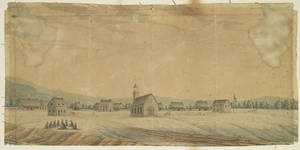Her People
A record of the people connected to Anahareo, by blood or by choice.
Ancestry
Most of the information pre-dating Anahareo's birth stems from oral tradition as passed to Anahareo by her grandmother. The information has not been verified through written records and much of it cannot be verified through such records, as none are known to exist. Anahareo’s grandmother, Catherine Bernard, reportedly told her the following story about her ancestry.
• Ancestry • Her Early Years • Anahareo & Grey Owl • Finding Her Own Way
• Her Later Years • Anahareo Remembered
In the early 19th century, Naharrenou, hereditary chief of the Mohawks, led a group of about 300 men, women and children into the wilderness from the Lake of Two Mountains, southwest of Montreal, in order to build up a resistance force against white settlers encroaching upon Indian lands. The Mohawks led a "hit-and-run" guerilla war against white settlements until Naharrenou was wounded in one of those raids. The leadership of the group then fell to his son, Kanistonou.
The Mohawks had a strict rule against taking prisoners for fear of a prisoner escaping and revealing their hide-out. Nonetheless, on one of the raids, a young Scottish settler by the name of Mary Robinson fled her village during the attack and eventually fell from exhaustion deep in the bush. This is where Kanistonou found her. Unable to kill her as required by the rules of the war, he had her taken back to the Mohawk camp and, with considerable difficulty, managed to get the council to tolerate her presence. Mary Robinson quickly learned the ways of the Mohawks and after a few years, when Kanistonou expressed his desire to marry her, no one objected. Their first child, Anahareo's grandmother, was born out of this union.
Eventually, the guerillas became more and more daring and finally the tide turned against them. Soldiers found them, went in, and killed most of them, including Mary Robinson, Kanistonou and a newborn son. Her grandmother, just a babe-in-arms, was taken to Montreal and given to nuns in a convent for raising.
As a young woman, her grandmother left the convent and rejoined her relatives at Oka, where they recognized her by a letter she possessed that carried Naharrenou's mark. She married Anahareo's grandfather there and the couple made their way west to an area just north of today's Belleville, Ontario. They farmed there and raised 11 children. After about 25 years, owing to the fact that Indians could not own land in those days, they were forced off their land and had to move again. They travelled in a north-westerly direction towards the Ottawa River and started a new life in the Mattawa area. This is where Anahareo was born in 1906.
NEXT: Her Early Years
The above account, which is drawn from Anahareo's book Devil in Deerskins: My Life with Grey Owl, seems to contradict the common belief that relations between the Iroquois and British were largely peaceful in Upper Canada after 1784, though it is possible that they took place in New York State or New England. This account is also inconsistent with historical census documents that appear to indicate that Catherine's parents -- Anahareo's great-grandparents -- were still alive when Catherine married.
As Anahareo herself noted that these stories from her childhood were difficult to remember, it is included here on the understanding that the Iroquois' oral tradition is generally regarded as accurate. However, that Anahareo's aunt, Kate Salter, also gave Catherine's mother's maiden name as Robinson suggests that Anahareo is not the only one who remembered this version of events.
It is worth noting that Lovat Dickson's book Wilderness Man: The Strange Story of Grey Owl provides a slightly different version of Anahareo's ancestry. Dickson's account claims that Mary Robinson was Catherine's grandmother, rather than her mother, and that she was captured in an Iroquois raid during the American Revolutionary War (1775-1783). Dickson's account also differs in that Mary Robinson marries Naharrenhou, and not his son.
